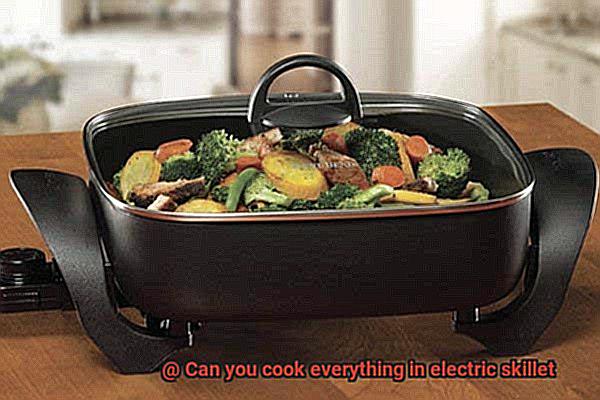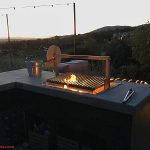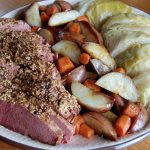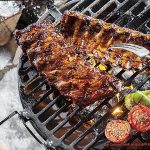Cooking is an art, and just like any artist, a cook needs the right tools to create a masterpiece. That’s where the electric skillet comes in. This versatile kitchen gadget can fry, sear, sauté, roast, and more. But the question on everyone’s mind is: can you cook everything in an electric skillet?
The answer is a resounding yes. Electric skillets are designed for versatility and can handle a wide range of meals. Whether you’re craving pancakes for breakfast or want to fry up some chicken for dinner, an electric skillet has got your back.
However, there are some things to keep in mind when cooking with an electric skillet. For instance, the size of the skillet matters, as does its coating and heat settings. These factors can impact the quality of your meal and your overall cooking experience.
So if you’re ready to take your cooking game up a notch with an electric skillet, then keep reading. In this post, we’ll cover everything from dos and don’ts to best practices. Join us on this culinary journey as we explore why an electric skillet might just become your new favorite kitchen tool.
Contents
What Is an Electric Skillet?
If you’re looking to enhance your cooking game, an electric skillet might just be the answer. This kitchen appliance is designed to cook food with ease and efficiency, thanks to its flat cooking surface that is heated by electricity. What’s more, the non-stick surface makes cleaning a breeze and prevents food from sticking.
Electric skillets come in various shapes and sizes, and some models even have adjustable temperature controls for precise cooking. The built-in lid is another great feature that helps trap moisture and heat inside the skillet for better-cooked meals. Additionally, electric skillets are versatile, making them ideal for frying, sautéing, grilling, roasting, and baking.
But as with any kitchen appliance, there are limitations to consider. The size of the skillet will affect what you can cook in it. For instance, a small electric skillet may not be suitable for roasts or whole chickens. And while electric skillets are great for many dishes, delicate fish or those that require high heat may not turn out as well.
What Can You Cook in an Electric Skillet?
One of the best things about an electric skillet is its versatility. You can cook almost any dish in it, from breakfast classics to hearty stews. Let’s dive into some of the mouth-watering dishes you can whip up with this appliance.
First up, pancakes. There’s nothing quite like starting your day with a stack of fluffy pancakes. With an electric skillet, making perfect pancakes is a breeze. Simply heat the skillet to your desired temperature, pour the batter onto the surface, and voila. The even heat distribution ensures that your pancakes will be evenly cooked and deliciously golden brown.
Next on the list are eggs. Whether you prefer scrambled, fried, or in an omelet, an electric skillet has got you covered. Its non-stick surface makes flipping and cooking eggs a breeze. And with its spacious surface area, you can cook multiple eggs at once – perfect for feeding a hungry crowd.
If you’re in the mood for something savory, why not try cooking up some bacon or sausages? An electric skillet’s high temperatures ensure that your meats will be crispy on the outside and cooked through on the inside. And with its built-in lid that traps moisture and heat for better-cooked dishes, your meats will be juicy and flavorful.
For a healthy meal option, stir-fry dishes are perfect for cooking in an electric skillet. The even heat distribution ensures that all ingredients are cooked evenly without burning. You can stir-fry a variety of ingredients like meat, veggies, and noodles for a tasty and nutritious meal.
Last but not least, stews can also be made in an electric skillet. The high sides of the skillet provide enough space for all ingredients to simmer and meld together perfectly. You can make stews with a variety of meats such as beef, chicken, or pork, along with veggies like carrots, potatoes, and onions.
Considerations When Choosing the Size of Your Electric Skillet
It’s important to choose the right size that fits your needs. Here are some expert tips to help you make the perfect decision.
Firstly, consider how many people you typically cook for. If you have a small family, then an 8-inch electric skillet should be sufficient. But if you’re frequently entertaining guests or cooking for a larger family, then a 12-inch skillet might be a better option.
Another factor to think about is the amount of counter space you have available. In a smaller kitchen, a smaller sized skillet would be more practical. However, if you have ample counter space and enjoy hosting dinner parties, then a larger skillet would be more appropriate.
When selecting the size of your electric skillet, it’s essential to think about the type of food you plan on cooking. If you’re cooking large cuts of meat or whole chickens, then a bigger skillet would be necessary. But if you prefer smaller portions or side dishes, then a smaller sized skillet would suffice.
Lastly, consider your storage space when choosing the size of your electric skillet. A smaller sized skillet is more practical if you have limited storage space or prefer appliances that are easy to store away. But if storage space is not an issue for you, then a larger skillet would be more versatile and perfect for cooking up larger meals.
Types of Foods That Cannot Be Cooked in an Electric Skillet
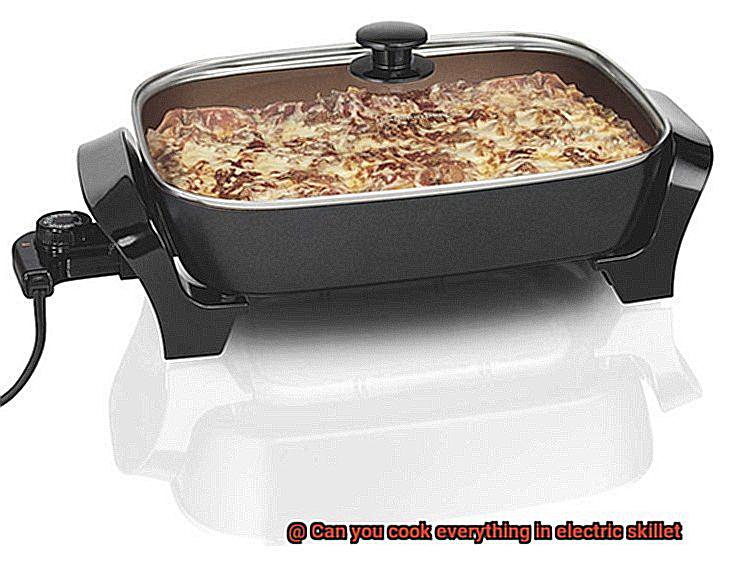
Electric skillets are a wonderful addition to any kitchen, offering a versatile and easy-to-use cooking appliance. However, it’s important to remember that there are certain types of foods that may not be suitable for cooking in an electric skillet. In this article, we’ll delve deeper into the types of foods that should be avoided when cooking with an electric skillet.
High-heat and fast-cooking dishes
One of the drawbacks of electric skillets is that they have a limited temperature range compared to gas stoves or charcoal grills. Therefore, foods that require high heat and fast cooking times may not produce the same results as traditional stovetop cooking. Dishes like stir-fries or seared steaks may not achieve the same level of char or sear on meats.
Liquid-heavy dishes
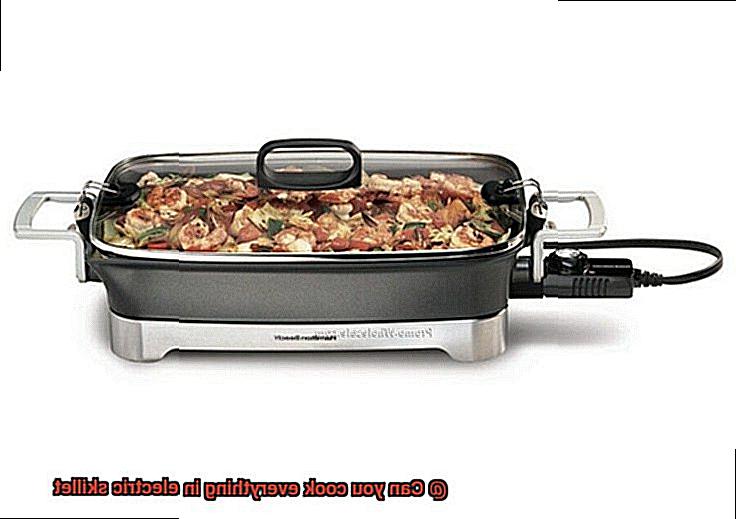
Electric skillets are designed to be shallow and do not have high sides, which means that they may not be able to hold enough liquid for certain types of dishes. Large pots of soup or stews may overflow in an electric skillet due to its limited capacity. Additionally, the non-stick surface of the skillet can make achieving a rolling boil challenging.
Constant stirring or flipping dishes
The large surface area of electric skillets can make it challenging to maintain even heat distribution across the entire surface. This can result in some areas of the food being overcooked while others are undercooked. Therefore, dishes that require constant stirring or flipping may not cook evenly in an electric skillet.
Deep-fried foods
While it may be tempting to try and fry up some chicken or French fries in your electric skillet, the high temperature required for deep frying can cause the skillet to overheat and potentially become damaged. Additionally, the oil used for deep frying can create a mess and be difficult to clean up from the skillet.
Delicate foods
Foods like fish or eggs require precise temperature control, which can be difficult to achieve with an electric skillet. Additionally, the non-stick coating on some electric skillets may not be suitable for cooking delicate foods, as they may stick or break apart during cooking.
Tips for Cooking with an Electric Skillet
Cooking with an electric skillet is a convenient and versatile way to prepare a wide range of dishes. However, to achieve the best results, there are some tips and tricks you should keep in mind. Here are five sub-sections that will help you cook with confidence:
Preheat the Skillet
Preheating your electric skillet is essential for evenly cooking your meal. It allows the skillet to reach the desired temperature before you start cooking. Preheat your skillet for a few minutes before adding any ingredients, and make sure it’s evenly heated before you begin.
Use the Right Temperature
Electric skillets come with temperature controls, so selecting the right temperature for your dish is crucial. For example, if you’re making pancakes or eggs, a low to medium heat setting will work well. If you’re searing meat or stir-frying veggies, a higher heat setting may be necessary. Be mindful of the temperature settings on your electric skillet as some dishes may require a lower temperature setting than others.
Don’t Overcrowd the Skillet
Overcrowding your electric skillet can cause your food to steam rather than brown, resulting in an unappetizing dish. To ensure even cooking and browning, keep some space between each piece of food.
Use Non-Stick Spray or Oil
To prevent your food from sticking to the skillet and ensure even cooking, it’s essential to use non-stick spray or oil. This will also make cleanup easier and prevent burning.
Keep the Lid On
Keeping the lid on your electric skillet can help retain moisture and prevent your food from drying out. This is especially important when cooking meats or other dishes that require longer cooking times. Be sure to check on your food regularly and adjust the temperature and lid accordingly.
Benefits of Cooking With an Electric Skillet
Versatility is the hallmark of electric skillets. From stir-fries to pancakes to stews and soups, you can cook just about anything in an electric skillet. Its non-stick surface also makes for easy clean-up and requires little to no oil or butter for cooking. This versatile kitchen tool is ideal for busy cooks, as it can handle a variety of dishes with ease.
But what really sets electric skillets apart is their precise temperature control. Unlike traditional stovetops that can have hot spots and uneven heat distribution, electric skillets heat evenly across the entire cooking surface. This means no more burnt edges or undercooked centers – just perfectly cooked meals every time. This precise temperature control also means that you can experiment with new recipes without worrying about burning or undercooking your meals.
Another benefit of electric skillets is their convenience. With a lid that traps in heat and moisture, they’re perfect for slow-cooking dishes like stews and roasts. You can set the temperature and leave it to cook while you tend to other tasks. Plus, they’re portable and can be used anywhere there’s an electrical outlet – perfect for camping trips or outdoor cooking adventures.
And let’s not forget about the energy savings. Electric skillets use less energy than traditional stovetops, which not only saves you money on your energy bill but also makes them a more eco-friendly option. You’ll feel good about not only the quality of your meals but also their impact on the environment.
Common Mistakes to Avoid When Using an Electric Skillet
By avoiding these slip-ups, you can ensure that your food is cooked to perfection every single time.
One of the most common mistakes people make is not preheating their skillet before cooking. This can result in uneven cooking and food sticking to the pan. To ensure even cooking, always preheat your electric skillet for at least 5-10 minutes before adding any ingredients. This will allow the skillet to reach the ideal temperature, ensuring that your food cooks evenly and doesn’t stick to the surface.
Another mistake to avoid is overcrowding the skillet. It’s tempting to add everything at once, but this can prevent your food from cooking evenly. To avoid this, leave enough space between each item to allow for proper heat circulation. This will guarantee that your food is cooked evenly from all sides and doesn’t end up burnt on one side and undercooked on the other.
Using the wrong utensils can also cause damage to your electric skillet. Metal utensils can scratch the non-stick coating, while plastic utensils may melt if they come into contact with the hot surface of the skillet. To avoid damaging your skillet, always use wooden or silicone utensils when cooking in an electric skillet. Not only will this prevent damage to the surface, but it will also ensure that your food doesn’t end up with bits of scratched non-stick coating mixed in.
Lastly, forgetting to clean your electric skillet after each use can lead to a build-up of grease and food residue. This can affect the performance of your skillet over time and make it less efficient at cooking your meals. To keep your electric skillet in top condition, be sure to clean it thoroughly after each use by wiping it down with a damp cloth and mild soap. This will ensure that it stays in great condition and performs well for years to come.
Cleaning and Maintaining Your Electric Skillet
Here are some essential tips to help you clean and maintain your electric skillet.
Firstly, it is important to unplug and let your electric skillet cool down before cleaning it. Once cooled, remove the temperature control probe and wash it separately. This step is vital as the probe should never be submerged in water.
Next, use a soft cloth or sponge to wipe down the inside of the skillet with warm, soapy water. Avoid using abrasive cleaners or steel wool as they can scratch the non-stick surface. If you have stubborn stains or burnt-on food, create a paste using baking soda and water. Apply the paste to the affected areas and let it sit for a few minutes before wiping it away with a soft cloth or sponge.
After cleaning the inside of the skillet, rinse it thoroughly with warm water and dry it completely with a soft cloth before storing it away. Storing a damp electric skillet could cause rust or damage to the non-stick surface.
When storing your electric skillet, ensure that you store it in a cool, dry place. Avoid stacking other items on top of it as this could also damage the non-stick surface. Additionally, store the temperature control probe separately from the skillet itself.
6u8sbhxvlGA” >
Conclusion
To put it simply, an electric skillet is a kitchen powerhouse that can handle almost any meal you throw at it. From frying to sautéing and everything in between, this versatile gadget makes cooking a breeze. So, can you cook everything in an electric skillet? Absolutely. However, it’s important to keep a few things in mind.
First and foremost, the size of your skillet matters. If you plan on cooking larger meals or batches of food, opt for a larger size to accommodate your needs. Additionally, consider the coating of your skillet and its heat settings. Some coatings may not be suitable for certain types of food or high-heat requirements.
But don’t let these limitations discourage you. Electric skillets come with adjustable temperature controls and various shapes and sizes to fit any cooking need. And when used correctly, they produce perfectly cooked meals every time.
To get the most out of your electric skillet, there are some essential tips and tricks to follow. Preheating before cooking ensures even heating throughout the meal. And using non-stick spray or oil prevents sticking and promotes even cooking.
When it comes time to clean up, remember to unplug your skillet first and let it cool down before washing separately from the temperature control probe. Use a soft cloth or sponge with warm soapy water (no abrasive cleaners or steel wool.) for best results.
In summary, an electric skillet is a must-have tool for anyone who loves versatile and convenient cooking while saving on energy costs.

